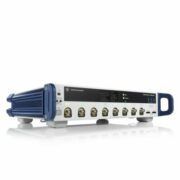Renesas Electronics Corporation (TSE:6723), a premier supplier of advanced semiconductor solutions, expanded its portfolio of mmWave solutions with the introduction of two new IC families for satellite communications (Satcom), radar, and phased array applications: The F65xx transmit active beamforming ICs and F692x low-noise amplifiers (LNAs). Featuring a combination of low power consumption, high gain, and compact size, the new solutions deliver a performance boost for antennas used in Satcom and radar systems.
The F65xx and F692x devices address the thermal and integration challenges designers face as they transition from bulky mechanically scanned antennas to lower weight and profile active electronically scanned array antennas (AESAs). The two new families support Satcom, radar and point-to-point communications applications in the Ku, Ka, and CDL frequency bands.
“When migrating to AESAs from mechanical antennas, our customers require reliable, compact and cost-effective ICs with exceptionally low power consumption and noise figures that meet their system EIRP and G/T requirements,” said Naveen Yanduru, Vice President of RF Communications, Industrial and Communications Business Division at Renesas. “We are excited about the emerging capabilities that our new IC families will enable, including in-flight live video conferencing, ubiquitous global broadband connectivity and all-weather radar situational awareness for autonomous vehicles and drones.”
About the New RF Solutions
The next generation of 8-channel F6521 (Ku), F6522 (Ka) and F6513 (CDL) Tx active beamforming ICs offers unprecedented performance in a small form factor satisfying the tight integration requirements of planar phased array antennas. They simultaneously satisfy both the effective isotropic radiated power (EIRP) and thermal dissipation requirements of terrestrial Satcom terminals operating on low/medium Earth orbit (LEO) and geosynchronous Earth orbit (GEO) satellite networks in the Ku- and Ka-band spectrum.
Additionally, higher phase and gain resolution are coupled with larger on-chip memory and advanced digital modes to enable precise beam pattern and polarization control, and rapid beam steering. The new ICs share the same physical footprint as the first-generation devices, reducing the required board re-design time when migrating to the second-generation ICs.










